Jiarui Liu
Combining LLM Semantic Reasoning with GNN Structural Modeling for Multi-View Multi-Label Feature Selection
Nov 19, 2025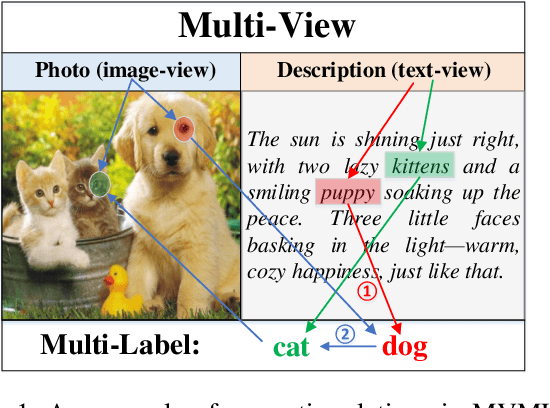



Abstract:Multi-view multi-label feature selection aims to identify informative features from heterogeneous views, where each sample is associated with multiple interdependent labels. This problem is particularly important in machine learning involving high-dimensional, multimodal data such as social media, bioinformatics or recommendation systems. Existing Multi-View Multi-Label Feature Selection (MVMLFS) methods mainly focus on analyzing statistical information of data, but seldom consider semantic information. In this paper, we aim to use these two types of information jointly and propose a method that combines Large Language Models (LLMs) semantic reasoning with Graph Neural Networks (GNNs) structural modeling for MVMLFS. Specifically, the method consists of three main components. (1) LLM is first used as an evaluation agent to assess the latent semantic relevance among feature, view, and label descriptions. (2) A semantic-aware heterogeneous graph with two levels is designed to represent relations among features, views and labels: one is a semantic graph representing semantic relations, and the other is a statistical graph. (3) A lightweight Graph Attention Network (GAT) is applied to learn node embedding in the heterogeneous graph as feature saliency scores for ranking and selection. Experimental results on multiple benchmark datasets demonstrate the superiority of our method over state-of-the-art baselines, and it is still effective when applied to small-scale datasets, showcasing its robustness, flexibility, and generalization ability.
Redundancy-optimized Multi-head Attention Networks for Multi-View Multi-Label Feature Selection
Nov 16, 2025Abstract:Multi-view multi-label data offers richer perspectives for artificial intelligence, but simultaneously presents significant challenges for feature selection due to the inherent complexity of interrelations among features, views and labels. Attention mechanisms provide an effective way for analyzing these intricate relationships. They can compute importance weights for information by aggregating correlations between Query and Key matrices to focus on pertinent values. However, existing attention-based feature selection methods predominantly focus on intra-view relationships, neglecting the complementarity of inter-view features and the critical feature-label correlations. Moreover, they often fail to account for feature redundancy, potentially leading to suboptimal feature subsets. To overcome these limitations, we propose a novel method based on Redundancy-optimized Multi-head Attention Networks for Multi-view Multi-label Feature Selection (RMAN-MMFS). Specifically, we employ each individual attention head to model intra-view feature relationships and use the cross-attention mechanisms between different heads to capture inter-view feature complementarity. Furthermore, we design static and dynamic feature redundancy terms: the static term mitigates redundancy within each view, while the dynamic term explicitly models redundancy between unselected and selected features across the entire selection process, thereby promoting feature compactness. Comprehensive evaluations on six real-world datasets, compared against six multi-view multi-label feature selection methods, demonstrate the superior performance of the proposed method.
Taming Object Hallucinations with Verified Atomic Confidence Estimation
Nov 12, 2025

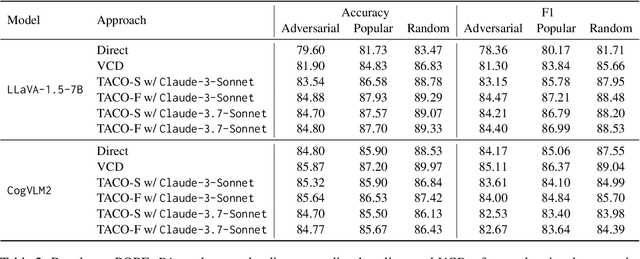
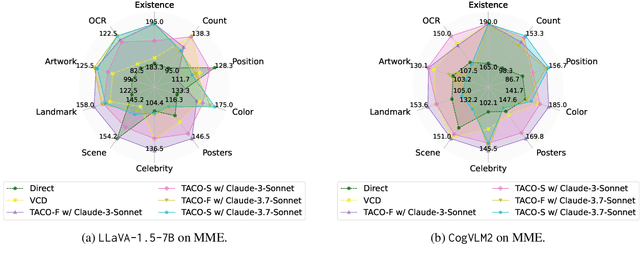
Abstract:Multimodal Large Language Models (MLLMs) often suffer from hallucinations, particularly errors in object existence, attributes, or relations, which undermine their reliability. We introduce TACO (Verified Atomic Confidence Estimation), a simple framework that mitigates hallucinations through self-verification and confidence calibration without relying on external vision experts. TACO decomposes responses into atomic queries, paraphrases them to reduce sensitivity to wording, and estimates confidence using self-consistency (black-box) or self-confidence (gray-box) aggregation, before refining answers with a language model. Experiments on five benchmarks (POPE, MME, HallusionBench, AMBER, and MM-Hal Bench) with two MLLMs (\texttt{LLaVA-1.5-7B} and \texttt{CogVLM2}) show that TACO consistently outperforms direct prompting and Visual Contrastive Decoding, reduces systematic biases, and improves confidence calibration, demonstrating its effectiveness in enhancing the faithfulness of MLLMs.
Stabilizing Reinforcement Learning for Honesty Alignment in Language Models on Deductive Reasoning
Nov 12, 2025Abstract:Reinforcement learning with verifiable rewards (RLVR) has recently emerged as a promising framework for aligning language models with complex reasoning objectives. However, most existing methods optimize only for final task outcomes, leaving models vulnerable to collapse when negative rewards dominate early training. This challenge is especially pronounced in honesty alignment, where models must not only solve answerable queries but also identify when conclusions cannot be drawn from the given premises. Deductive reasoning provides an ideal testbed because it isolates reasoning capability from reliance on external factual knowledge. To investigate honesty alignment, we curate two multi-step deductive reasoning datasets from graph structures, one for linear algebra and one for logical inference, and introduce unanswerable cases by randomly perturbing an edge in half of the instances. We find that GRPO, with or without supervised fine tuning initialization, struggles on these tasks. Through extensive experiments across three models, we evaluate stabilization strategies and show that curriculum learning provides some benefit but requires carefully designed in distribution datasets with controllable difficulty. To address these limitations, we propose Anchor, a reinforcement learning method that injects ground truth trajectories into rollouts, preventing early training collapse. Our results demonstrate that this method stabilizes learning and significantly improves the overall reasoning performance, underscoring the importance of training dynamics for enabling reliable deductive reasoning in aligned language models.
Humanizing Machines: Rethinking LLM Anthropomorphism Through a Multi-Level Framework of Design
Aug 25, 2025Abstract:Large Language Models (LLMs) increasingly exhibit \textbf{anthropomorphism} characteristics -- human-like qualities portrayed across their outlook, language, behavior, and reasoning functions. Such characteristics enable more intuitive and engaging human-AI interactions. However, current research on anthropomorphism remains predominantly risk-focused, emphasizing over-trust and user deception while offering limited design guidance. We argue that anthropomorphism should instead be treated as a \emph{concept of design} that can be intentionally tuned to support user goals. Drawing from multiple disciplines, we propose that the anthropomorphism of an LLM-based artifact should reflect the interaction between artifact designers and interpreters. This interaction is facilitated by cues embedded in the artifact by the designers and the (cognitive) responses of the interpreters to the cues. Cues are categorized into four dimensions: \textit{perceptive, linguistic, behavioral}, and \textit{cognitive}. By analyzing the manifestation and effectiveness of each cue, we provide a unified taxonomy with actionable levers for practitioners. Consequently, we advocate for function-oriented evaluations of anthropomorphic design.
Synthetic Socratic Debates: Examining Persona Effects on Moral Decision and Persuasion Dynamics
Jun 14, 2025Abstract:As large language models (LLMs) are increasingly used in morally sensitive domains, it is crucial to understand how persona traits affect their moral reasoning and persuasive behavior. We present the first large-scale study of multi-dimensional persona effects in AI-AI debates over real-world moral dilemmas. Using a 6-dimensional persona space (age, gender, country, class, ideology, and personality), we simulate structured debates between AI agents over 131 relationship-based cases. Our results show that personas affect initial moral stances and debate outcomes, with political ideology and personality traits exerting the strongest influence. Persuasive success varies across traits, with liberal and open personalities reaching higher consensus and win rates. While logit-based confidence grows during debates, emotional and credibility-based appeals diminish, indicating more tempered argumentation over time. These trends mirror findings from psychology and cultural studies, reinforcing the need for persona-aware evaluation frameworks for AI moral reasoning.
UniTEX: Universal High Fidelity Generative Texturing for 3D Shapes
May 29, 2025Abstract:We present UniTEX, a novel two-stage 3D texture generation framework to create high-quality, consistent textures for 3D assets. Existing approaches predominantly rely on UV-based inpainting to refine textures after reprojecting the generated multi-view images onto the 3D shapes, which introduces challenges related to topological ambiguity. To address this, we propose to bypass the limitations of UV mapping by operating directly in a unified 3D functional space. Specifically, we first propose that lifts texture generation into 3D space via Texture Functions (TFs)--a continuous, volumetric representation that maps any 3D point to a texture value based solely on surface proximity, independent of mesh topology. Then, we propose to predict these TFs directly from images and geometry inputs using a transformer-based Large Texturing Model (LTM). To further enhance texture quality and leverage powerful 2D priors, we develop an advanced LoRA-based strategy for efficiently adapting large-scale Diffusion Transformers (DiTs) for high-quality multi-view texture synthesis as our first stage. Extensive experiments demonstrate that UniTEX achieves superior visual quality and texture integrity compared to existing approaches, offering a generalizable and scalable solution for automated 3D texture generation. Code will available in: https://github.com/YixunLiang/UniTEX.
Step1X-3D: Towards High-Fidelity and Controllable Generation of Textured 3D Assets
May 12, 2025Abstract:While generative artificial intelligence has advanced significantly across text, image, audio, and video domains, 3D generation remains comparatively underdeveloped due to fundamental challenges such as data scarcity, algorithmic limitations, and ecosystem fragmentation. To this end, we present Step1X-3D, an open framework addressing these challenges through: (1) a rigorous data curation pipeline processing >5M assets to create a 2M high-quality dataset with standardized geometric and textural properties; (2) a two-stage 3D-native architecture combining a hybrid VAE-DiT geometry generator with an diffusion-based texture synthesis module; and (3) the full open-source release of models, training code, and adaptation modules. For geometry generation, the hybrid VAE-DiT component produces TSDF representations by employing perceiver-based latent encoding with sharp edge sampling for detail preservation. The diffusion-based texture synthesis module then ensures cross-view consistency through geometric conditioning and latent-space synchronization. Benchmark results demonstrate state-of-the-art performance that exceeds existing open-source methods, while also achieving competitive quality with proprietary solutions. Notably, the framework uniquely bridges the 2D and 3D generation paradigms by supporting direct transfer of 2D control techniques~(e.g., LoRA) to 3D synthesis. By simultaneously advancing data quality, algorithmic fidelity, and reproducibility, Step1X-3D aims to establish new standards for open research in controllable 3D asset generation.
SAM-Guided Robust Representation Learning for One-Shot 3D Medical Image Segmentation
Apr 29, 2025
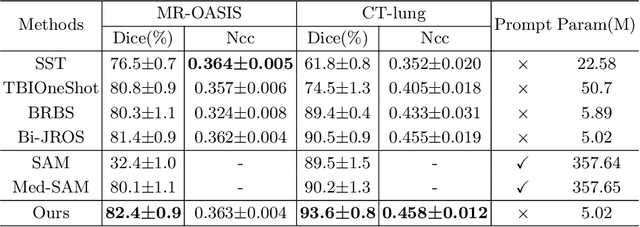


Abstract:One-shot medical image segmentation (MIS) is crucial for medical analysis due to the burden of medical experts on manual annotation. The recent emergence of the segment anything model (SAM) has demonstrated remarkable adaptation in MIS but cannot be directly applied to one-shot medical image segmentation (MIS) due to its reliance on labor-intensive user interactions and the high computational cost. To cope with these limitations, we propose a novel SAM-guided robust representation learning framework, named RRL-MedSAM, to adapt SAM to one-shot 3D MIS, which exploits the strong generalization capabilities of the SAM encoder to learn better feature representation. We devise a dual-stage knowledge distillation (DSKD) strategy to distill general knowledge between natural and medical images from the foundation model to train a lightweight encoder, and then adopt a mutual exponential moving average (mutual-EMA) to update the weights of the general lightweight encoder and medical-specific encoder. Specifically, pseudo labels from the registration network are used to perform mutual supervision for such two encoders. Moreover, we introduce an auto-prompting (AP) segmentation decoder which adopts the mask generated from the general lightweight model as a prompt to assist the medical-specific model in boosting the final segmentation performance. Extensive experiments conducted on three public datasets, i.e., OASIS, CT-lung demonstrate that the proposed RRL-MedSAM outperforms state-of-the-art one-shot MIS methods for both segmentation and registration tasks. Especially, our lightweight encoder uses only 3\% of the parameters compared to the encoder of SAM-Base.
Revealing Hidden Mechanisms of Cross-Country Content Moderation with Natural Language Processing
Mar 07, 2025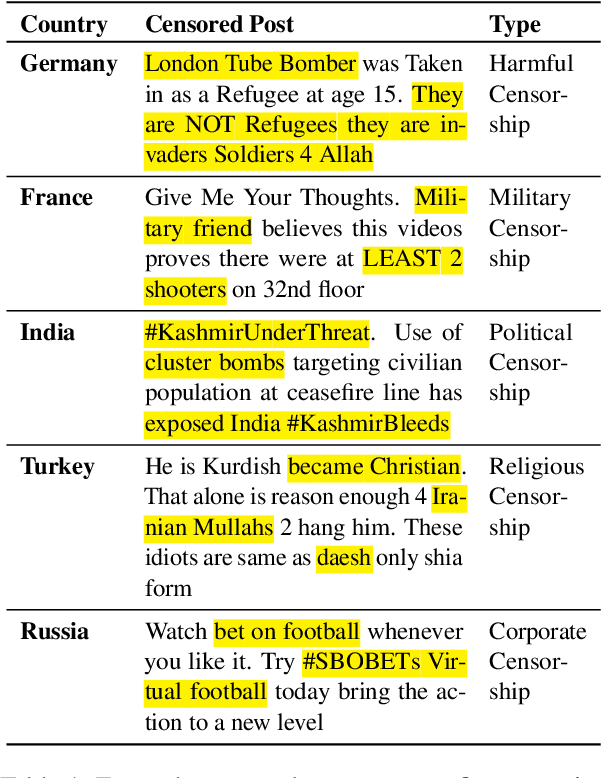
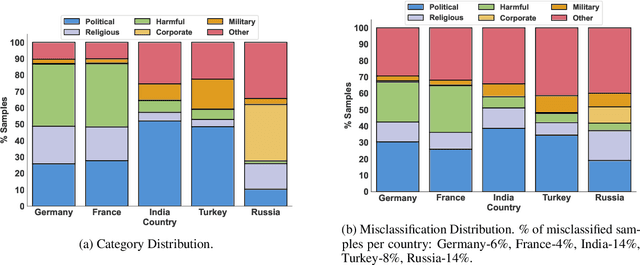
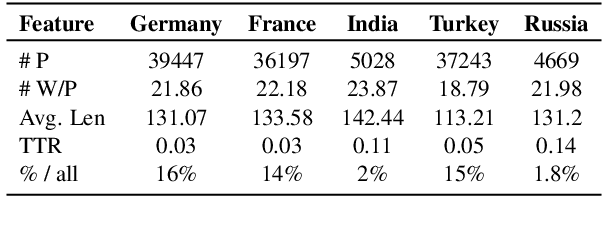
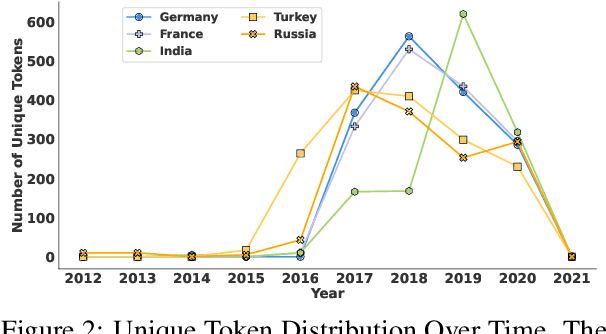
Abstract:The ability of Natural Language Processing (NLP) methods to categorize text into multiple classes has motivated their use in online content moderation tasks, such as hate speech and fake news detection. However, there is limited understanding of how or why these methods make such decisions, or why certain content is moderated in the first place. To investigate the hidden mechanisms behind content moderation, we explore multiple directions: 1) training classifiers to reverse-engineer content moderation decisions across countries; 2) explaining content moderation decisions by analyzing Shapley values and LLM-guided explanations. Our primary focus is on content moderation decisions made across countries, using pre-existing corpora sampled from the Twitter Stream Grab. Our experiments reveal interesting patterns in censored posts, both across countries and over time. Through human evaluations of LLM-generated explanations across three LLMs, we assess the effectiveness of using LLMs in content moderation. Finally, we discuss potential future directions, as well as the limitations and ethical considerations of this work. Our code and data are available at https://github.com/causalNLP/censorship
 Add to Chrome
Add to Chrome Add to Firefox
Add to Firefox Add to Edge
Add to Edge